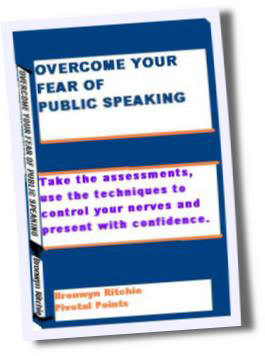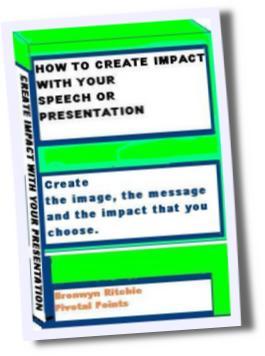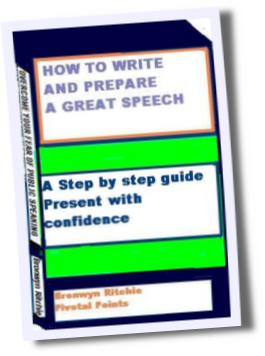|
The Art of Using Humor
in Public Speaking:
Psychology
of Humor
Because humor is such a powerful emotion, it is a good
idea to understand (if that is possible), the
psychological basis of humor. More specifically, what
makes laughter and the humorous situation "work". Your
assignment, from now on, is, when you hear people laugh,
to ask yourself, "Why did they laugh"? This attention
will sharpen your skills at recognizing possible
material for your own use and help you get a feeling for
what makes humor work.
The response of laughter is based on two general
situations. Humor either plays a trick on the mind or it
paints a picture which is ludicrous or incongruous.
Jokes are the 1st type; they play a pleasant trick on
your mind. When something is ludicrous, you visualize a
situation in which the elements are in some way
incongruous. A word of warning here. The minute you try
to dissect a joke, or explain it, it ceases to be funny.
You can study humor down to the most tenuous theories,
reading what scientists have discovered about it through
the years to the point where it may ruin your enjoyment
of laughter. I recommend that you do read several books
on the subject. The 1st should be "The Enjoyment of
Laughter" by Max Eastman. He spends a fair amount of
time on the psychology of humor, but leaves it up to the
reader to delve further into the subject.....at their
own risk. "The Enjoyment of Laughter" is a
practical book as well as a serious study of humor and
serves well as a starting point for your studies; a
definite must for your new library. While it is out of
print, you can find copies at used bookstores or on the
Internet for around $30.00.
Dr. Jarvis shares two definitions of humor with us. The
1st is "a painful thing told playfully". The second is
"tragedy separated by time and space". Note that both
definitions treat humor as a serious thought viewed in a
light manner. Ever heard someone say, "I laughed so hard
I nearly cried"? Humor deals with serious subjects and
is close to pathos: an emotion of sympathetic pity.
Think about the old gag of someone slipping on a banana
peel. Such an accident usually elicits a laugh. We might
giggle or snicker when someone else takes a flyer.
Perhaps though not when we ourselves are the victim. The
laugh would be stopped mid-snort though if the person
was hurt in the fall. Why? Because the playful element
has been lost. Buster Keaton does a pratfall. Down he
goes, but he must get up. Eastman talks about
this at length, referring to the absolute necessity for
the participants to be "in fun". Charlie talks at length
about the feeling of being "in fun" so I've included
Eastman's four laws of humor at this point.
Understanding this concept and being able to perceive if
an audience is "in fun" has a direct bearing on your use
of humor.
Max Eastman presents four laws of humor, all related to
the concept of being "in fun". My observations are in
italics.
1. The first law is that things can be funny only when
we are "in fun". There may be a serious thought or
motive lurking underneath our humor. We may be only
"half in fun" and still perceive things as funny. Ask
yourself, "Is this audience "in fun"; do I dare use
humor; can they be moved into "in fun""?
|
When an audience is "in fun", they will take
your humor and words in a playful way and
enjoy them as well. When however, they are
"dead earnest" it is humor that is dead.
Faced with an audience in such a mood, humor
may require an extremely delicate and
practiced application. Better to not try to
get a laugh than have one flop in such a
situation. You must be able to read your
audience accurately. |
2. The second law is that when we are "in fun", a
peculiar shift of values takes place. Pleasant things
are still pleasant, but disagreeable things, so long as
they are not disagreeable enough to "spoil the fun",
tend to acquire a pleasant emotional flavor and provoke
a laugh. Someone who can think funny has the natural
ability to see the humor in the painful lessons of life.
3. The third law is that being "in fun" is a condition
most natural to childhood, and that children at play
reveal the humorous laugh in its simplest and most
omnivorous form. To them every untoward, unprepared for,
unmanageable, inauspicious, ugly, disgusting, puzzling,
startling, deceiving, shaking, blinding, jolting,
deafening, banging, bumping, or otherwise shocking and
disturbing thing, unless it be calamitous enough to
force them out of the mood of play, is enjoyable as
funny. Can something be said carelessly by a speaker
that can move an audience out of "in fun"? A speaker
must be aware of the mood of the audience at all times.
4. The fourth law is that grown-up people retain in
varying degrees this aptitude for being in fun and thus
enjoying unpleasant things as funny. But those not
richly endowed with humor manage to feel a very comic
feeling only when within, or behind or beyond, or
suggested by, the playfully unpleasant thing, there is a
pleasant one. Only then do they laugh uproariously like
playing children. And they call this complicated thing
or combination of things at which they laugh, a joke.
Audiences made up of individuals who have retained in
varying degrees the aptitude for being "in fun" provide
the humorous speaker with a great challenge; that of
reaching all present. Like Charlie says, some members of
the audience are thinking, "OK Buster, lets see if you
can make me laugh....... "
In regards to being "in fun", never were more
illuminating words spoken about humor than those spoken
by the hero of the Virginian. He said, "Smile when you
say that!" In that case the difference between being "in
fun" and not being "in fun" might have been a
well-placed bullet. Eastman relates the feeling to the
experience of wrestling around with a dog. You are
rough-housing, wrestling, playing and all the while the
dog's tail is wagging wildly; you know the dog is "in
fun". Compare that to the demeanor of a strange dog
guarding a strangers yard. That dog is not "in fun".
But, back to the psychology of humor. Considering that
humor is a painful thing told playfully, we see that
discomfort is a key element in the makeup of a joke.
Often the discomfort of others. We may feel superior due
to a momentary instance where others are placed in an
embarrassing situation. For the speaker, that simple
fact has important ramifications. You certainly do not
want to make your audience or any particular member of
the group feel inferior.
In breaking the ice and becoming a welcome speaker,
there is no better way than to make yourself the butt of
the joke. Self-effacing humor is always safe in that you
appear human to your audience and you do not risk
offending them in any way. So an excellent rule of thumb
to follow is:
|
Play it safe, use self effacing humor. |
Tony Audrieth
1515 Waverly Dr.
Champaign, IL 61821
www.squaresail.com/onhumor.html
|

Take the assessments, use the techniques to
control your nerves and present with
confidence.
Click here for the
eBook:
Overcome
your
Fear of Public
Speaking

You can create the image, the message and
the impact that you choose
How to Create Impact with Your Presentation

Get this step-by-step guide from original
thought through to presenting a
well-structured speech with confidence
How to Write
a Great Speech
|
|